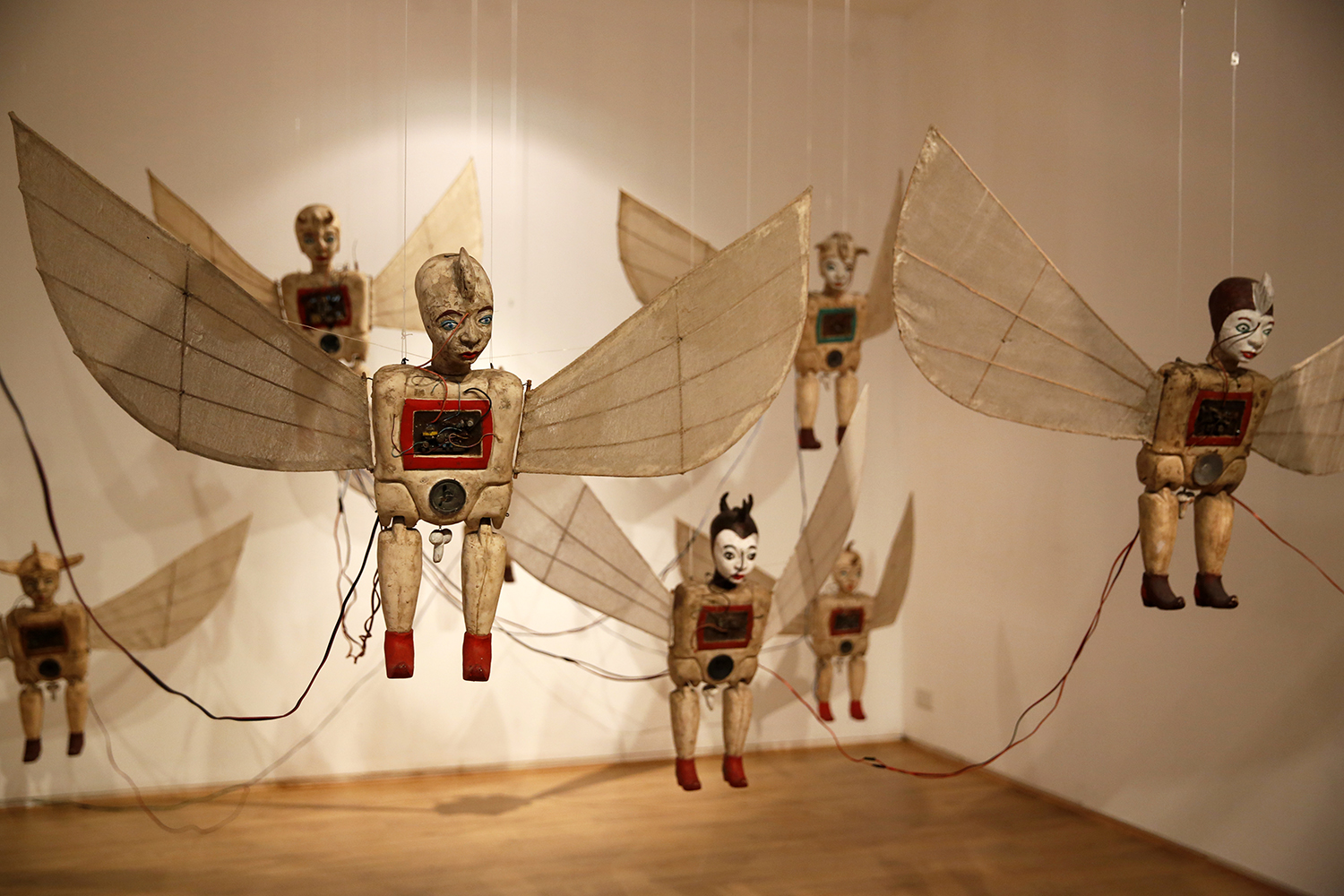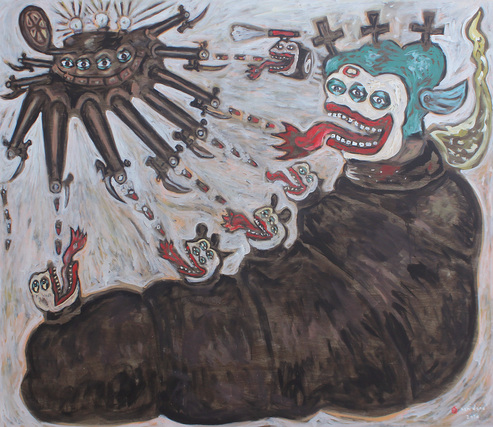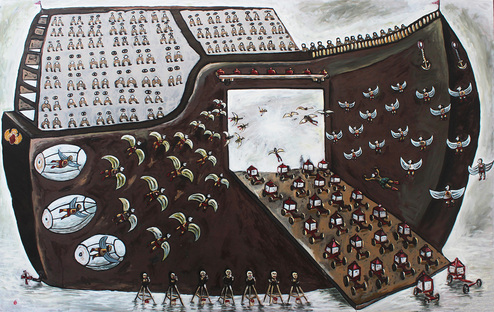Shows
Heri Dono’s “Angel’s Exodus”


Heri Dono uses his colorful and bawdy sense of humor as a coping mechanism to process the political and social eruptions of his native Indonesia. Born in Jakarta in 1960, Dono is a product of the turbulent post-colonial era in Indonesia, when a military coup led to mass killings and political purges. Confrontations in his artwork between dinosaurs and men, or between monsters and war machines, expressed in his trademark style rooted in Javanese shadow theater, speak to an uneasy relationship between the armed forces and his fellow civilian population. Installations utilizing glancing light and cacophonous sound come off as foreboding, though Dono’s “Angel’s Exodus,” currently on display at Tang Contemporary Art’s Bangkok gallery, conveys a sense of quasi-optimism. The artist uses a combination of contemporary culture and traditional Indonesian motifs to juxtapose ludicrous fantasies with real-world situations, and comments on current events with an unholy irreverence usually reserved for political cartoonists. Filtered through Dono’s surrealistic sensibilities, the results are comedic musings on dead serious subjects like the role of the military in governance and genocide.
The exhibition spans 20 years of the illustrious artist’s career, collecting works that exorcise angels from a religious context to symbolise the human spirit. Flying Angels (1996) is an installation that hangs from the ceiling in suspended animation, awaiting visitors to press a switch. Once triggered, 10 clockwork fiberglass and bamboo bodies jerk to life, flapping wings and turning heads. The shifting shade cast on the gallery’s walls call to mind the influential Javanese wayang kulit, or shadow puppets, which have entertained the Javanese people for over a millennium. After a minute or so of discordant dance, the angels return to rest—but their eyes never close.

Winged angels can be found elsewhere too, in two paintings—The Flying Angels I and II (both 2014)—in which they ascend against a smoggy, polluted green field, each with the head of a young woman and an ebony body. On their chests are open windows that show bright blue skies contained within; their spirits exit those inner, perfect worlds and join us in gloom. The exodus of these tiny souls from flying bodies and their persevering rise beyond the means of their material frames is a hopeful message—compelling ideas matter, regardless of our circumstances.

The Troops of Cakra (2015) is an installation that features a fleet of nearly identical, wheeled vehicles with flag-bearing dinosaurs at their helms. Presumably a reference to the soldiers who stood as a last ditch effort against Dutch colonialists in the 1890s, the uniformity of these units fails to survive closer inspection. Atop each vehicle is a glass case, which holds a distinct human couple. Observers cannot help but imagine the lives shared by each confined pair. At the press of a foot pedal, the contraptions comes alive with the pageantry of beating drums and flashing lights. Their march, in place and out of sync, leads one to question the advances of post-colonial military rule.
Three of the paintings on display were created in 2016; they follow the same template of confrontation. Weapon’s Creature Shoot the Mother Earth depicts a flying saucer outfitted with bayoneted rifles, engaging a grub-like monstrosity presumed to be “Mother Earth.” As violence spews forth from the embodiment of industrialized militarism, Mother Earth’s many mouths devour the bullets and appear to be launching a counter attack, illustrating the mistreatment of the natural world by technology and steel—and the dire consequences. In A Soldier Do Dialogue with a Hybrid Creature, Dono’s idiosyncratic arrangement describes an ongoing conversation between the military and a “hybrid creature” of civilian populations. The soldier brandishes his tiny pistol overhead and shouts while the hybrid sticks out all three of his tongues. This is an impasse, a theme which continues in The First Dinosaur who Discover Human Beings, in which a showdown takes place between an astonished prehistoric monster and an equally surprised group of soldiers. The two parties bring weapons to bear on each other, confronting the unknown with a threat of mutually assured destruction.


Another canvas, The Ark (2014), shows several figures from Dono’s other creations, such as Troops and Flying Angels. They are boarding a massive maritime vessel, likely in anticipation of a cataclysmic flood. Perhaps Dono had the apocalypse on his mind as he wielded the brush; two years later, we have not managed to pull ourselves away from the point of no return. In fact, we seem closer than ever to an ideological and environmental end of days. The hope is, as in Noah’s tale, that eventually the waters will recede, and Dono and his fellow artists will be free to disembark on dry land.
Heri Dono’s “Angel’s Exodus” was on view at Tang Contemporary Art , Bangkok, until December 31, 2016.







